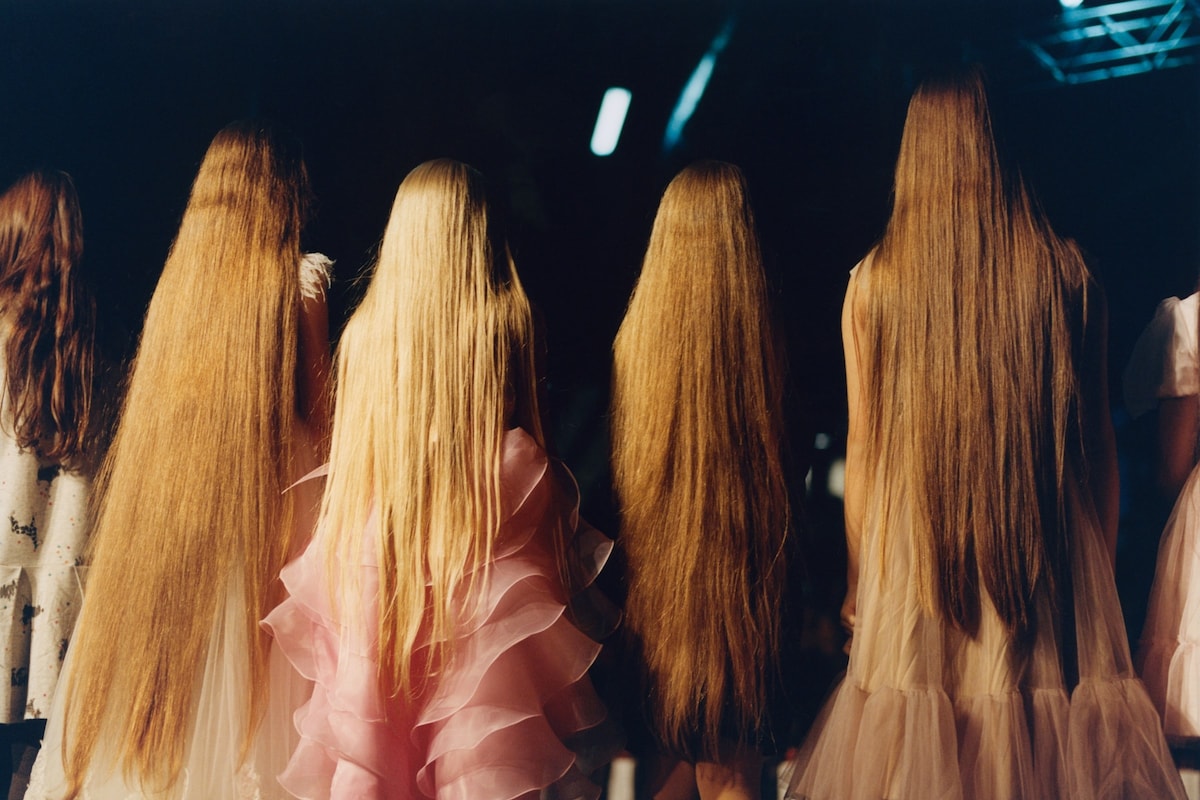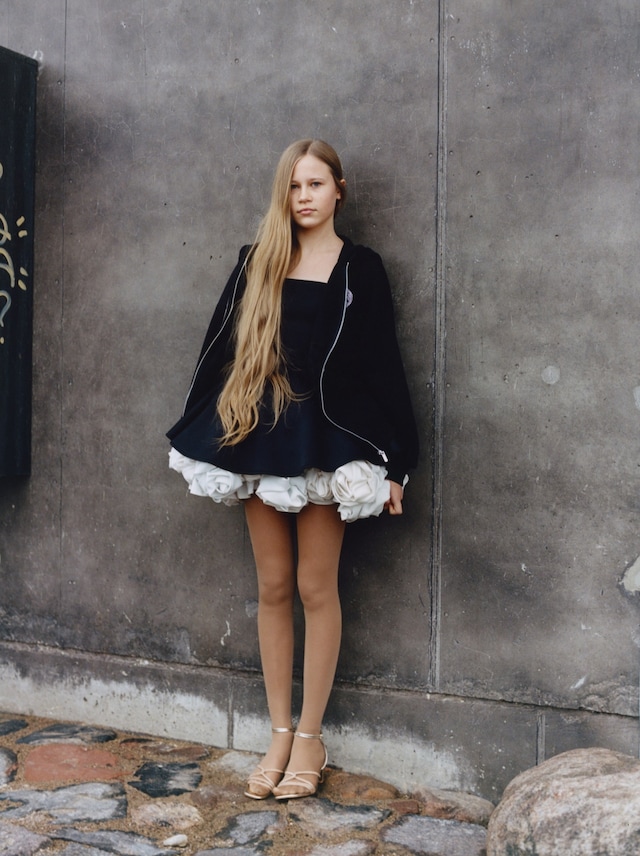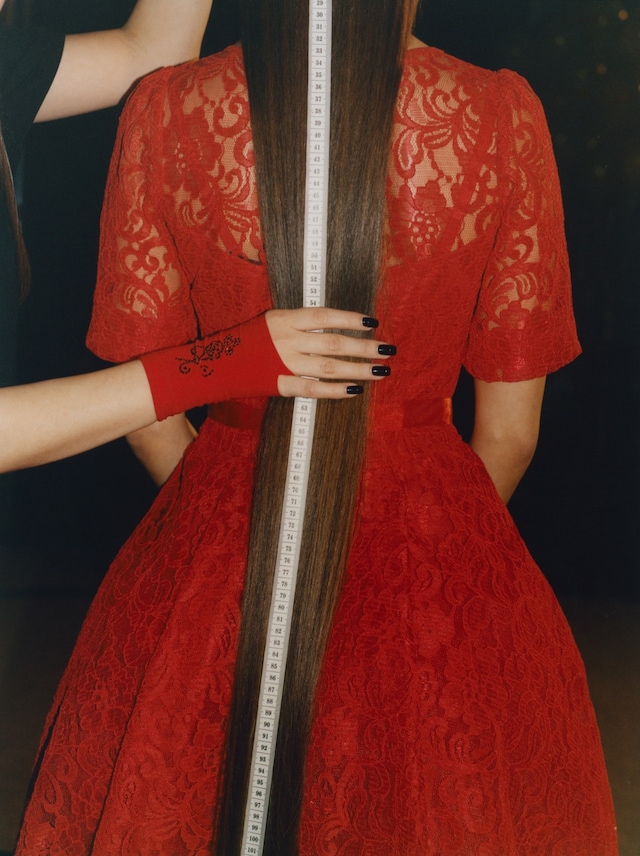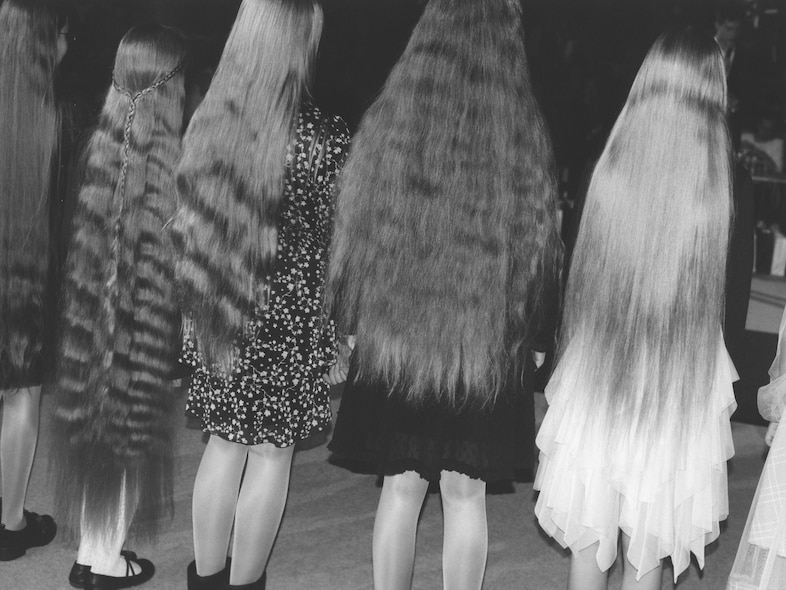
Rewrite
Francesca Allen’s new exhibition documents the customs and characters behind a long hair contest that has taken place in Lithuania for 20 years
Across cultures, long hair has been tied to various ideas of power. In the Bible, Samson’s locks were the source of his strength; for Celtic and Norse warriors, it was a signifier of status; and in China’s Huangluo village, generations of women have cut their hair only once, at 18, in a ritual linked to prosperity. In Lithuania, long hair has roots in pagan stories of witches and magical power – but in 2025, at Konkursas Pasaulio Ilgaplaukes, the World’s Longest Hair contest, the custom has morphed to become something else entirely. Blending folklore, pageantry, and personal obsession, Francesca Allen’s new project Plaukai documents the competition’s surreal undertakings with a gentle observational eye.
Allen is a Hackney-based photographer who has spent much of her career studying women, from teenage girls on the cusp of adulthood to her own sister, Alida. Allen is usually meticulously controlled in her practice, but this project forced her to throw her rule book out of the window, capturing spontaneous moments as the contest unfolded over a cold November day last year. As Lithuanian pop blared from speakers, girls lined up on stage – long locks trailing over party dresses – to have their hair measured by red-gloved invigilators before an arena of spectators. Shot sensitively from the perspective of an outsider, Allen offers a glimpse into a world where archaic beauty ideals are both imposed by parents and reclaimed by a new, TikTok-savvy generation as a form of self-expression.
As the images go on show at east London gallery Allotment – alongside a pocket-sized book made with art director Adam Ridgeway – Francesca Allen reflects on the making of the project, the contest’s clash of myth and modernity, and our cultural fixation with hair.

“Years ago, there was an image floating around on Tumblr of a long hair contest in Lithuania, so I’d always vaguely known that these kinds of events existed. I started properly researching this specific iteration of the competition six years ago. There’s not too much about it online, but it’s been running for two decades now.
“Initially, I wanted to do a much bigger project, a documentary film, but the logistics were too complicated and expensive so I decided to go on a recce trip and take some images instead. One of my best friends, Karolina [Pazereckaite], is Lithuanian and a producer, so I asked her to come with me. We’d been given permission to photograph the event, but we weren’t totally sure what we were walking into. My thinking was: if I came away with ten images, I’d be happy.
“The morning we arrived, we milled around outside for a bit. It was November in Lithuania, very gloomy and dark. I had brought all ISO 400 film, but quickly realised I’d have to push all of it and underexpose it. I had to work quickly and make a lot of decisions on the spot, which isn’t how I’m used to shooting.

“Then the girls arrived. I had no idea what was going on at any given moment because I don’t speak the language. The competition takes place in an arena. Each age group lines up at the side, and a man with a microphone calls the girls up on stage one by one. Two women in red gloves measure the hair from root to tip. Before the prize ceremony, the girls line up in height order on stage, then all turn around and shake their hair at the audience. It’s incredibly weird and amazing.
“I went into the day thinking it would have more history behind it, but it actually felt quite pageant-y. Everyone was dressed to the nines. Hardcore pop music blared from the speakers all day. There’s also a section called Women’s World, with trade booths selling shaving cream, nail polish, and other beauty products.

“While it wasn’t exactly what I was expecting, we met some amazing young women and interviewed a few of them for the book. They spoke about why they grow their hair and what it means to them. For one girl, being in the contest had been a dream since she was little. Another girl talked about wanting to cut her hair soon. In Lithuania, there’s a lot of folklore around hair and history behind it. But I think that as a world, we are totally obsessed with hair. Especially for women, it’s such a huge part of our identity.
“I always refer back to this book called Girls! Girls! Girls!, which is a brilliant collection of essays. There’s a quote that describes girlishness not as an age, but as an allegorical state of mind. I kept thinking about that during the competition – watching grown women on stage, shaking their hair, being playful but also taking everything quite seriously.

“I didn’t go in knowing exactly what I wanted from the trip, which is probably why I ended up with something that feels quite new for me. I threw myself into a different environment without expectations, and with less control over the images – but actually, it was a really freeing way of working. I’m not the type of person who documentary photography comes easily to, as I’m never going to be someone to be bold and insert myself into situations. But I hope that I can approach things quietly and with a sensitive eye, and that this comes across in my work.”
Plaukai by Francesca Allen is on show at Allotment in London until 25 June 2025.
in HTML format, including tags, to make it appealing and easy to read for Japanese-speaking readers aged 20 to 40 interested in fashion. Organize the content with appropriate headings and subheadings (h1, h2, h3, h4, h5, h6), translating all text, including headings, into Japanese. Retain any existing
tags from
Francesca Allen’s new exhibition documents the customs and characters behind a long hair contest that has taken place in Lithuania for 20 years
Across cultures, long hair has been tied to various ideas of power. In the Bible, Samson’s locks were the source of his strength; for Celtic and Norse warriors, it was a signifier of status; and in China’s Huangluo village, generations of women have cut their hair only once, at 18, in a ritual linked to prosperity. In Lithuania, long hair has roots in pagan stories of witches and magical power – but in 2025, at Konkursas Pasaulio Ilgaplaukes, the World’s Longest Hair contest, the custom has morphed to become something else entirely. Blending folklore, pageantry, and personal obsession, Francesca Allen’s new project Plaukai documents the competition’s surreal undertakings with a gentle observational eye.
Allen is a Hackney-based photographer who has spent much of her career studying women, from teenage girls on the cusp of adulthood to her own sister, Alida. Allen is usually meticulously controlled in her practice, but this project forced her to throw her rule book out of the window, capturing spontaneous moments as the contest unfolded over a cold November day last year. As Lithuanian pop blared from speakers, girls lined up on stage – long locks trailing over party dresses – to have their hair measured by red-gloved invigilators before an arena of spectators. Shot sensitively from the perspective of an outsider, Allen offers a glimpse into a world where archaic beauty ideals are both imposed by parents and reclaimed by a new, TikTok-savvy generation as a form of self-expression.
As the images go on show at east London gallery Allotment – alongside a pocket-sized book made with art director Adam Ridgeway – Francesca Allen reflects on the making of the project, the contest’s clash of myth and modernity, and our cultural fixation with hair.

“Years ago, there was an image floating around on Tumblr of a long hair contest in Lithuania, so I’d always vaguely known that these kinds of events existed. I started properly researching this specific iteration of the competition six years ago. There’s not too much about it online, but it’s been running for two decades now.
“Initially, I wanted to do a much bigger project, a documentary film, but the logistics were too complicated and expensive so I decided to go on a recce trip and take some images instead. One of my best friends, Karolina [Pazereckaite], is Lithuanian and a producer, so I asked her to come with me. We’d been given permission to photograph the event, but we weren’t totally sure what we were walking into. My thinking was: if I came away with ten images, I’d be happy.
“The morning we arrived, we milled around outside for a bit. It was November in Lithuania, very gloomy and dark. I had brought all ISO 400 film, but quickly realised I’d have to push all of it and underexpose it. I had to work quickly and make a lot of decisions on the spot, which isn’t how I’m used to shooting.

“Then the girls arrived. I had no idea what was going on at any given moment because I don’t speak the language. The competition takes place in an arena. Each age group lines up at the side, and a man with a microphone calls the girls up on stage one by one. Two women in red gloves measure the hair from root to tip. Before the prize ceremony, the girls line up in height order on stage, then all turn around and shake their hair at the audience. It’s incredibly weird and amazing.
“I went into the day thinking it would have more history behind it, but it actually felt quite pageant-y. Everyone was dressed to the nines. Hardcore pop music blared from the speakers all day. There’s also a section called Women’s World, with trade booths selling shaving cream, nail polish, and other beauty products.

“While it wasn’t exactly what I was expecting, we met some amazing young women and interviewed a few of them for the book. They spoke about why they grow their hair and what it means to them. For one girl, being in the contest had been a dream since she was little. Another girl talked about wanting to cut her hair soon. In Lithuania, there’s a lot of folklore around hair and history behind it. But I think that as a world, we are totally obsessed with hair. Especially for women, it’s such a huge part of our identity.
“I always refer back to this book called Girls! Girls! Girls!, which is a brilliant collection of essays. There’s a quote that describes girlishness not as an age, but as an allegorical state of mind. I kept thinking about that during the competition – watching grown women on stage, shaking their hair, being playful but also taking everything quite seriously.

“I didn’t go in knowing exactly what I wanted from the trip, which is probably why I ended up with something that feels quite new for me. I threw myself into a different environment without expectations, and with less control over the images – but actually, it was a really freeing way of working. I’m not the type of person who documentary photography comes easily to, as I’m never going to be someone to be bold and insert myself into situations. But I hope that I can approach things quietly and with a sensitive eye, and that this comes across in my work.”
Plaukai by Francesca Allen is on show at Allotment in London until 25 June 2025.
and integrate them seamlessly into the new content without adding new tags. Ensure the new content is fashion-related, written entirely in Japanese, and approximately 1500 words. Conclude with a “結論” section and a well-formatted “よくある質問” section. Avoid including an introduction or a note explaining the process.


